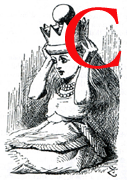
arroll's Red Queen redefines the word "snob." Not only does she possess all the arrogance and contempt that goes with aristocracy, she also possesses the pedantry of a prudish adult. As she haughtily tells Alice, she owns all the ways in the Looking-glass world and no one else. If this weren't enough power, the Queen also tries to control other people's behavior. She orders Alice to "curtsey," to "look up," to 'speak nicely," to not twiddle her thumbs, to open her mouth a little wider, and, of course, to always say, "Your Majesty." The Red Queen represents authoritative adults as a child would see them — as exacting and trifling. Through this hyperbolic character that one can only have in fantasy, Carroll mocks the class divisions of the real world and parodies the strictness by which adults try to mold children's behavior.
In Carroll's topsy-turvy realm, the Red Queen seems even more immature than Alice. Every time Alice says she sees something grand or unusual, the Queen says she has seen something better — a better garden, a bigger hill, even more nonsensical nonsense. The Red Queen, like many of Carroll's adult characters, exudes some of the same qualities which Anthony Wohl claims Victorians attributed to blacks and the lower classes; she is "cruel, childlike, irresponsible, impulsive, and self-indulgent" ( Catherine Ionata, "Prejudice and Perception in Alice in Wonderland"). In the nineteenth century, with the advent of scientific theories by Darwin, Lyell, Spencer, and Wallace, and as man's close relationship to the other beasts of nature grew increasingly apparent, many English people began manipulating the pseudo-science of phrenology to justify their rule and supposed superiority over other races and classes.
According to Wohl's "The Function of Racism in Victorian England," class prejudices served as "agents of political power": By attributing an innate criminality and childishness to the working-class people, the higher echelons of English society asserted their right to control and guide those beneath them. This moral guidance, however, seems just as ridiculous as the Red Queen's didacticism. By inverting class stereotypes, Carroll effectively shows that qualities of childishness and immorality do not attach themselves to people of one economic level or another, thereby dismantling the arguments for English classism.
Although Jane Eyre does not seem so concerned with issues of race and class, it too points out the prejudices of Victorian times. When Jane first arrives at Morton, Hannah confronts her about her social standing: "Did you ever go a-begging afore you came here?" (p. 300). Because Jane wears soiled clothes and looks sickly, Hannah assumes she belongs to the lower classes. Hannah's bluntness, however, carries with it a deprecatory tone. She views begging as a low-life, criminal act. Her thinking does not account for misfortunes befalling the well-to-do, does not recognize that unjust circumstances might drive an intelligent woman to beg out of necessity. Hannah, then, expresses the same opinion of the lower classes that Carroll satirizes above. She believes beggars are born criminals. And like Carroll, Charlotte Brontë assaults this supposition. With Jane as her mouthpiece, Brontë forthrightly criticizes Hannah's beliefs. Jane Eyre explains that "prejudices...are most difficult to eradicate from the heart whose soil has never been loosened or fertilised by education" (p. 299). In contrast to Carroll, who used hyperbole and an inversion of reality to make his point, Brontë here sticks to the confines of the material world and manipulates the thoughts of her character to deliver a short treatise on British classism. The irony of Hannah's prejudice, however, still shines through: it is ignorance that leads the upper class to believe it has the moral intelligence to guide the lower ones.
Content last modified May 1994